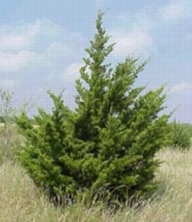

Common Names: Red
Cedar, grave yard tree
Genus: Juniperus
Species: virginiana

The Eastern Red Cedar is a small evergreen that commonly grows to a height of 10-50 feet. Its name is misleading since it is a juniper and not a cedar. Its range is from Nova Scotia to northern Florida, and west to the Dakotas and Texas. They can grow in any type of soil, and will take over abandoned fields and fence rows. Eastern Red Cedars prefer full sun and seedlings don't grow well in forests. When red cedars are found growing in a forest, you can be sure they started growing when it was an open field.
The Eastern Red Cedar grows in a pyramid shape. The top rounds off as it grows older. It has two types of leaves. The older leaves are flat and scale-like and only 1/16 of an inch long. The younger leaves are sharp-pointed and may be up to 3/4 of an inch long. They have whitish lines on top. In the summer they are a brilliant green, but in the winter they can turn copper yellow to rusty brown.
The wood of the Eastern Red Cedar is very durable and often used as fence posts. It contains an oil that repels moths. The oil is also used in medicines and perfume. The bark is reddish brown and peels off in stringy strips. It can be used to make a reddish dye.
Male and female flowers of the Eastern Red Cedar grow on separate trees. The fruit of the Eastern Red Cedar are a waxy, bluish berry about 1/4 of an inch in diameter, and are covered with a white powder.
The Eastern Red Cedar is a slow growing tree and lives to be very old. It gets its name, grave yard tree, because of an old superstition that says, when a red cedar you planted grows tall enough to shade your grave, it will be time for you to die.
The tree's fruit provides food for animals such as pheasants, Cedar wax-wings and other song birds. Birds eat the seeds and spread them. Many animals use it as food and shelter in the winter. The wood is used to make fence posts and wooden pencils.
Samantha S. 2000.
Bibliography:
"Welcome to the PLANTS National Database",http://plants.usda.gov/, (June 2000)
"Red Cedar (Juniperous virginiana)", http://www.dnr.state.wi.us/org/land/forestry/treeid/TreePgs/junipvirg. htm , (Sept. 2000).
"LCRA &endash; Diamonds in the rough - Eastern Red Cedar", http://www.lcra.org/.../organism/plants/ easternredcedar.htm, (8/23/02)
"Eastern Redcedar", http://www.conservation.state.mo.us/nathis/plantpage/flora/motrees/p7. htm, (8/22/02)